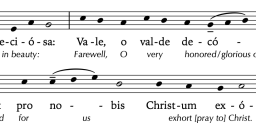Representing a horizontal episema in modern notation
-
At the beginning of the Alma Redemptoris Mater, there is a held note that in chant notation is pointed with a horizontal episema. Would a tenuto be a good choice for representing this in modern notation? I am trying to avoid doubling the value.
-
Does this count as a tenuto? Whatever it is, it seems fairly standard. One might be able to import one's own bar using Musescore (which is what I use — I can only handle one text-based markdown system at a time!), but I personally just use the default tenuto, dots, and vertical markings when messing with Gregorian scores based on the Solesmes books needed in modern notation. If anyone has more expert advice, however, I'm also all ears.Thanked by 1Kathy
-
Yes, that's the standard representation in modern notation.Thanked by 1Kathy
-
My first encounter with the tune was in Dufay's setting, so I understand the question even after seeing the unmarked version in Liber cantualis (p70); my LU has a dot (p278) and a dash for the in cantu simplici version (p282).
Tenuto will indeed be understood as the equivalent, and thus probably doubled by those so trained unless there is explicit direction; for contexts like "Tu quae genuisti" a poco rall. might be safer. -
I have given my parish the general instruction that a black note is regular/short (ie-keep flowing), a tenuto is lengthened (approx. 1.5) and a white note head is 'long' (ie-doubled). These are all "approximate" however, and not mathematical. Natural flow is to be observed. But in general, a tenuto marking works well and people understand it on the whole.

 Screen Shot 2022-03-08 at 8.13.50 AM.png1100 x 410 - 61K
Screen Shot 2022-03-08 at 8.13.50 AM.png1100 x 410 - 61K -
How do you represent psalm tones then if you use white note heads for something else?
-
How do you represent psalm tones then if you use white note heads for something else?
Half-note heads for longs (white notes).
Double whole notes for multiple syllables in psalm tones. -
Richard Crocker's Gradual Psalms as well as The Plainsong Psalter use parentheses for the 'extra' psalm tone notes.
-
Double whole notes for multiple syllables in psalm tones.
I also do this. I find it particularly helpful for multiple reasons:
1.) it removes visual clutter
2.) makes it immediately clear that you keep singing the same pitch until new notes appear on the stave
3.) people's eyes instinctually gravitate back to the text because there's no music to keep an eye on, so the proclamation of the text tends to follow natural speech rhythm much better.
In fact, I've even taken to adding long rectangular bars to indicate reciting tones, specifically. It's very clear and makes the chanted part distinct from the accompaniment if there is one.
 Screen Shot 2022-03-08 at 5.39.44 PM.png1254 x 204 - 37K
Screen Shot 2022-03-08 at 5.39.44 PM.png1254 x 204 - 37K
Welcome to the MusicaSacra Forum!
To participate in the discussions on Catholic church music, sign in or register as a forum member, The forum is a project of the Church Music Association of America.
Categories
- All Discussions21,154
- General Music Discussion8,235
- Job Openings204
- Management of Music Programs850
- Choral Matters533
- Church Documents and Rubrics526
- CMAA Notes303
- Events719
- For Newcomers: Read First26
- Sacred Polyphony547
- Hymnody872
- Gregorian Chant: General2,702
- ↳ Graduale Romanum and Liber Usualis368
- ↳ Graduale Simplex60
- ↳ Semiology63
- Vernacular Plainsong696
- Anglican Use and Anglican Chant68
- Organ, Other Instruments and Repertoire435
- New Composition/Works in Progress1,295
- Recordings234
- Music for Hispanic Ministry159
- Music Education: Children211
- Music Education: General222
- News Items245
- Positions Wanted2
- General Discussion: Catholicism739
- Amusements177
- General Discussion1,035
- Opinions119


